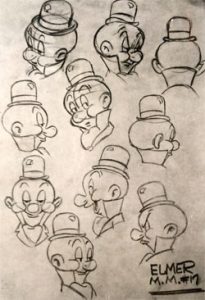


 Seeds of future animation greatness are planted in Elmer’s Candid Camera. The Warner Bros.“Merrie Melodies” short, which celebrates its 85th anniversary this month, features a redesigned version of Elmer Fudd and an early appearance of a troublesome rabbit who would later become Bugs Bunny.
Seeds of future animation greatness are planted in Elmer’s Candid Camera. The Warner Bros.“Merrie Melodies” short, which celebrates its 85th anniversary this month, features a redesigned version of Elmer Fudd and an early appearance of a troublesome rabbit who would later become Bugs Bunny.
Elmer’s Candid Camera is a time-capsule glimpse at what would become one of animation history’s greatest character relationships. It was also directed by the one and only Chuck Jones, who would go on to helm some of Bugs and Elmer’s greatest cartoon shorts.
As Elmer’s Candid Camera opens, we meet mild-mannered Elmer preparing his camera equipment for a trip into the forest and reading a book, “How to Photograph Wildlife.” In the next scene, in the forest, camera and tripod in tow, Elmer spots “wabbit twacks!”
 Elmer spots a sleeping rabbit, but as he stops to set up the shot, the rabbit stands behind him, asks, “What’ya doin? Takin’ pictures?” and adds, “Nice hobby. Mind if I watch?”
Elmer spots a sleeping rabbit, but as he stops to set up the shot, the rabbit stands behind him, asks, “What’ya doin? Takin’ pictures?” and adds, “Nice hobby. Mind if I watch?”
Elmer soon realizes that the rabbit behind him is the one he was trying to get a photograph of, and that same rabbit would continue to taunt and torture Elmer for the remainder of the picture.
Pulling the camera lens back so that it snaps into Elmer’s face and playing dead after being caught in a net are just two of the rabbit’s stunts that infuriate Elmer as the short progresses. It eventually leads to a full-blown breakdown for Elmer, where he trashes his camera and equipment.
Elmer eventually jumps into a lake, and the rabbit rescues him, pulling him out of the water and repeatedly asking him if he is doing okay. When Elmer says he is, the rabbit kicks Elmer back into the water, laughs, and throws the wildlife book at him as the conclusion.
The short marked a turning point for Elmer, who had been undergoing a metamorphosis. With Elmer’s Candid Camera, he would become a character in design and personality that audiences would become most familiar with through the years.
 Actor Authur Q. Bryan would voice Elmer here for the first time, providing the mild-mannered performance with the substitutions of “w’s” for “r’s,” which would become Elmer Fudd’s signature. At the time, Bryan was a popular actor on radio and a cast member on the hit series Fibber McGee and Molly and would go on to voice the character until his death in 1959.
Actor Authur Q. Bryan would voice Elmer here for the first time, providing the mild-mannered performance with the substitutions of “w’s” for “r’s,” which would become Elmer Fudd’s signature. At the time, Bryan was a popular actor on radio and a cast member on the hit series Fibber McGee and Molly and would go on to voice the character until his death in 1959.
Another familiar and renowned voice is also heard in Elmer’s Candid Camera. Mel Blanc provides the voice for the rabbit, who would be a prototype for Bugs. However, the voice Blanc provides sounds nothing like the familiar Bugs Bunny voice, but it is closer to Woody Woodpecker. Blanc had been providing Woody’s voice at this time, and in Elmer’s Candid Camera, the rabbit sounds like the famous Woodpecker and seems to break out into a version of Woody’s trademark laugh.
Director Jones has several of his other future collaborators on the short, including writer Rich Hogan and animator (and future director) Robert McKimson.

 Elmer’s Candid Camera contains many elements that would become standards of Jones’ future work, including slow builds, pauses around jokes, and explosive animation (particularly during Elmer’s breakdown at the conclusion).
Elmer’s Candid Camera contains many elements that would become standards of Jones’ future work, including slow builds, pauses around jokes, and explosive animation (particularly during Elmer’s breakdown at the conclusion).
Interestingly, years later, Jones wrote in his 1989 book, Chuck Amuck: The Life and Times of an Animated Cartoonist, that he was not all that fond of this short: “It is obvious when one views this cartoon, which I recommend only if you are going to die of ennui, that my conception of timing and dialogue was formed by watching the action in the La Brea tar pits. It would be complimentary to call it sluggish.”
The legendary Jones may have been too hard on himself. Eighty-five years later, many feel that Elmer’s Candid Camera was planting those comedic seeds from which all the future Warner Bros animated gold would bloom.